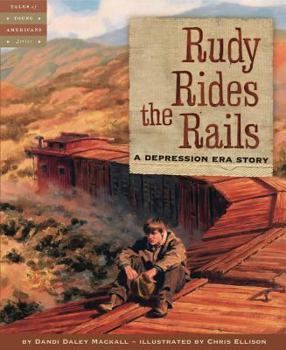Rudy Rides the Rails: A Depression Era Story
(Part of the Tales of Young Americans Series)
In 1932, Akron, Ohio was no better off than other parts of the country. Since Black Tuesday in '29, companies are closed, men all over the state are out of work, and families are running out of hope. Thirteen-year-old Rudy wants to help but doesn't know where to turn. His father, sullen and withdrawn, spends his time sulking on their front porch. His mother is desperate, not knowing how she will feed and care for her family. When Rudy learns of other boys leaving town and heading west to seek their fortunes, he hops a train figuring at least there will be one less mouth to feed at home. As Rudy lives the hobo life while he "rides the rails" to California, young readers are given a snapshot view and testament of Depression-era America.Writer Dandi Daley Mackall met the real "Ramblin' Rudy" in 2000 and was inspired to capture his story and the spirit of adventure shown by many during the Great Depression. She conducts writing workshops across the United States and speaks at numerous conferences. Dandi lives in West Salem, Ohio. Rudy Rides the Rails is Chris Ellison's second book with Sleeping Bear Press. He also illustrated Let Them Play, which was named to the 2006 Notable Social Studies Trade Books for Young People list. Chris is presently working on another Tales of Young Americans story about the Oklahoma Land Run. He lives in Hattiesburg, Mississippi.
Format:Hardcover
Language:English
ISBN:1585362867
ISBN13:9781585362868
Release Date:March 2007
Publisher:Sleeping Bear Press
Length:40 Pages
Weight:1.10 lbs.
Dimensions:0.4" x 9.3" x 11.1"
Age Range:4 to 8 years
Grade Range:Grades 1 to 3
Customer Reviews
4 ratings
Excellent book
Published by Thriftbooks.com User , 16 years ago
I read this book out loud to a group of 21 elementary students learning about the Great Depression. It summed up what I was trying to teach them about hoboes better than anything I could have said myself and left them spellbound. I highly recommend it.
Rutgers University Project on Economics and Children
Published by Thriftbooks.com User , 16 years ago
Rudy, a thirteen-year old boy, and his family face extreme hardship during the Great Depression. More than half of all workers in Akron, Ohio, had lost their jobs, including Rudy's father, and new paid work was difficult to find. Ma waited in relief lines for what could often be stale and moldy food, and Rudy's sisters found sustenance at the soup kitchen and local mission. Not wanting to be a burden on his struggling family, Rudy decided to take a step similar to other teenagers he had heard about: he hopped a train to go West as a hobo. Dreams of a better life in California and the chance to send money back home helped to sustain him as he experienced hunger, cold, fear, and fatigue while traveling. Along the way, Rudy learned of a hidden network of kindhearted strangers who made it a point to feed hungry hobos passing through. While the Great Depression may seem like a distant and obscure event to young children, this exceptional book brings the topic to life with its moving text and realistic illustrations. According to the author's note, a quarter of a million teenagers turned to hobo life as a survival strategy during the Depression, facing issues similar to those that the homeless face today. As historical fiction, Rudy Rides the Rails does an excellent job in providing children with a rich context for understanding problems of unemployment, scarcity, and recession in the economic world around them.
A picturebook featuring dark, softly painted yet realistic paintings by award-winning children's boo
Published by Thriftbooks.com User , 18 years ago
Author and novel-writing teacher Dandi Daley Mackall presents Rudy Rides the Rails: A Depression Era Story, a picturebook featuring dark, softly painted yet realistic paintings by award-winning children's book artist Chris Ellison. Though Rudy Rides the Rails is a work of historical fiction, the story and earthy art tones are meant to capture the spirit of Americans who lived through the hard times of the Great Depression. Young Rudy leaves home in search of work, or at least hoping to give his family one fewer mouth to feed. He rides the rails as a hobo puts in backbreaking effort, and finds that the kindness of strangers goes a long way. A special glossary of Depression-era and hobo terms (such as "Hoover blanket" for newspapers used as blankets, because many blamed then-President Hoover for the bad economy) and hobo signs (such as a smiling cat to represent kindness) rounds out this fascinating and nostalgic picturebook, recommended for children who are just about ready to make the transition to chapter books due to the quantity of story text.
Beautiful, fun, inspiring!
Published by Thriftbooks.com User , 18 years ago
I loved this realistic slice of what life was like as a teen hobo during the Depression. Hoboes left secret signs carved on trees or buildings to warn fellow hoboes of trouble ahead or kindness and a good meal. A touching, uplifting story--a book for every age!





